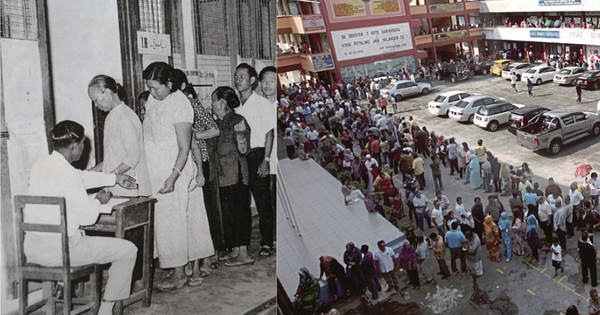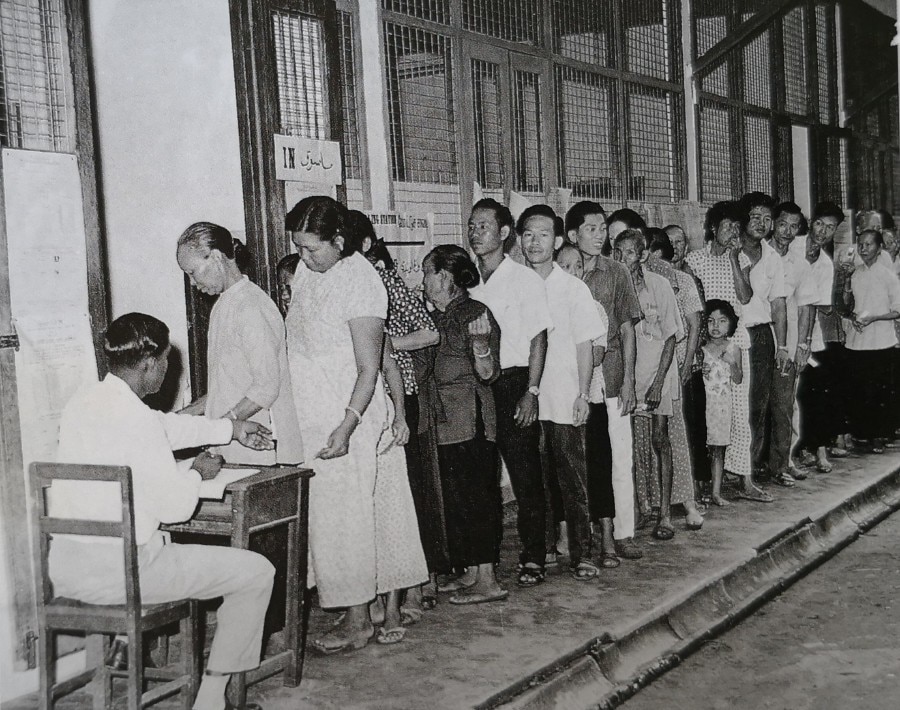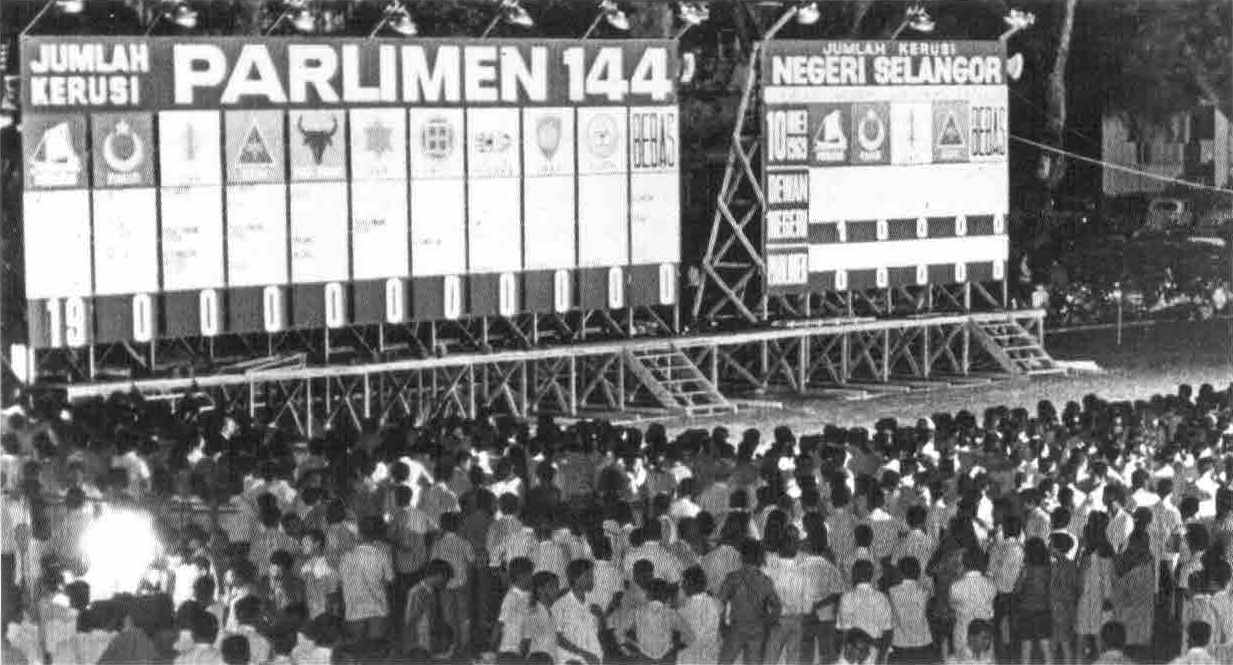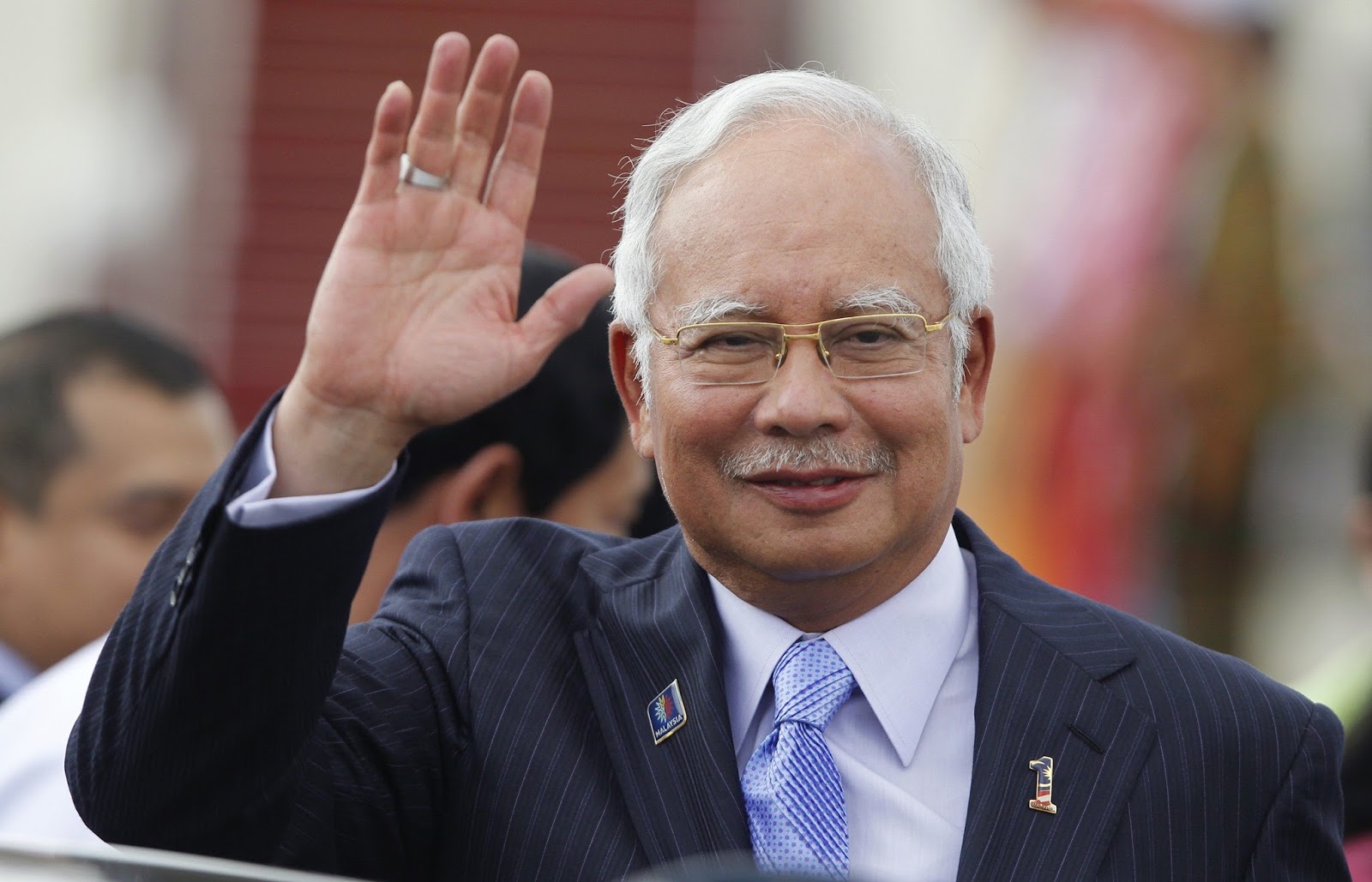Here's A Look At The Voter Turnout Of Every General Election Held In Malaysian History
Numbers give an interesting insight.
The 14th General Election is just around the corner
On 9 May, 14,806,185 registered voters will be casting their ballot papers to choose their respective representatives for Parliament and State Legislative Assemblies.
For the first time in 19 years, polling day this GE14 falls on a weekday, on 9 May 2018.
During early voting on 5 May, Saturday, 83% of the 278,590 early voters (the Armed Forces and the police, including retired personnel) have fulfilled their voting responsibilities for GE14, reported NST Online.
The ballot papers from early voting are kept in police lock-ups and will be tabulated on 9 May from 4pm with the process being witnessed by the candidates' agents.
"Mahathir" and "Najib" showed up to the same polling station to cast their votes on 5 May.
Image via NST OnlineThere are 14,806,185 registered voters, but it's the percentage of voters who will actually turn up to cast their ballot that will determine BN's 61-year grip on power
On that note, let's take a look at the voter turnout throughout the past general elections.
Malaysia's first general election
Coincidently, the very first general election was held on a Wednesday.
It was held on 27 July 1955, yes, before Malaya's independence in 1957, for the purpose to elect members of the Federal Legislative Council.
At that time, there were 1,280,855 registered voters, out of which 1,027,211 turned out to vote, making the voter turnout a healthy percentage of 82.8%.
The Alliance Party, which consisted of UMNO, MCA, and MIC, won around 80% of the total vote and 51 out of 52 seats contested. It allowed the Alliance Party to form the new government, with its leader Tunku Abdul Rahman becoming Chief Minister (Ketua Menteri Persekutuan Tanah Melayu).
On 19 August 1959, before the formation of Malaysia, a general election was held. It was the first parliamentary election held for members of the Federation of Malaya.
Again, the polling day fell on Wednesday.
During the 1959 general election (GE1), the number of registered voters almost doubled. There were 2,177,650 registered voters, out of which 1,564,575 turned up to vote.
However, while the number of registered voters had almost doubled, the turnout percentage fell by a margin of almost 10%. Voter turnout was 73.3%. The drop in percentage was in sharp contrast to the voter turnout of 82.8% during 1955.
The Alliance Party won the election and with its 71.1% majority formed a government.
The 2nd General Election in 1964: Voter turnout was 78.9%, an increase of 5.6% from GE1
GE2 was held on Saturday, 25 April 1964, during which a total of 2,681,895 people were registered as voters, out of which 535,287 did not turn up to vote.
It was the first parliamentary general election held after the formation of Malaysia in 1963, and the first time that polling day fell on a weekend.
The 3rd General Election in 1969: Voter turnout fell by 5.3%. It was also the first time the Alliance Party lost its two-thirds majority.
It was held on Saturday, 10 May 1969.
While the ruling Alliance Party, comprising UMNO, MCA, and MIC, returned to power, it did so with a reduced majority because the Parti Gerakan Rakyat Malaysia (Gerakan) and the Democratic Action Party (DAP) made major gains in the election.
It was the first time DAP had contested a general election, and the democratic socialist party went on to win 13 Parliamentary seats and 31 State Assembly seats.
In GE3, the registered voters' numbers were 3,450,000, out of which 2,532,042 turned up to cast their ballot giving 54 seats to Opposition. Voter turnout was 73.6%.
It was the first time that the Alliance Party lost its two-thirds majority in the Parliament, thus losing the power to pass most constitutional amendments.
For the first time, Malaysia's 4th general election (GE4) was held between a period of 22 days, with 75.1% voter turnout
It was held between Saturday, 24 August and Saturday, 14 September 1974.
By 1974, while the total number of registered voters had increased to 4,178,914, only 2,220,186 voters could cast their vote.
This was due to the fact that as candidates in 47 constituencies were unopposed, it did not allow 1,060,871 registered voters from these constituencies to cast their ballots.
The voter turnout increased by a mere 0.2% during GE5
The 5th Malaysian general election was held between Saturday, 8 July and Saturday, 22 July 1978, during which the total number of registered voters was 5,059,689.
With 3,596,732 people turning to cast their ballots, the voter turnout was 75.3%.
While Barisan Nasional maintained its majority in the Malaysian Parliament and formed the government, the opposition garnered 42.8% of total votes.
Voter turnout during GE6 increased by 0.1% to 75.4% with a total of 4,296,312 voters
The 6th general election was held between Thursday, 22 April and Monday, 26 April 1982. There were a total of 6,081,628 registered voters eligible to cast their ballots.
The 6th general election saw Dr Mahathir bin Mohamad of UMNO become the fourth Prime Minister of Malaysia, who went on to hold the office from 1981 to 2003, making him the longest-serving prime minister in the history of Malaysia.
The 7th General Election saw a voter turnout of 74.39%
During GE7, which was held between Saturday, 2 August and Sunday, 3 August 1986, the total number of registered voters was 6,791,446. Out of which, 4,752,004 in all 177 parliamentary constituencies turned out to cast their ballots.
In 1990, Malaysia held its 8th General Election
Voter turnout during GE8, which was held on a weekend, and with a significant increase in the number of registered voters, still fell by 2.36%. Voter turnout was 72.3%.
Held between Saturday, 20 October and Sunday, 21 October 1990, GE8 saw a total of 5,751,725 out of 8,000,000 registered voters turn up to cast their ballots.
The number of registered voters who did not vote in GE8 was 2,248,275, an increase of 208,833 when 2,039,442 did not vote in the 7th General Election.
During GE9, voter turnout hit its lowest percentage. With polling day held on a weekday, voter turnout was 68.3%.
The 9th General Election was held between Monday, 24 April and Tuesday, 25 April 1995, and saw a total of 6,152,809 out of 9,012,370 registered people who turned up.
The number of registered people who did not vote in GE9 increased to 2,859,561.
Malaysia's 10th General Election was, once again, held on a weekday. The voter turnout increased by 1%.
During GE10, which was held on Monday, 29 November 1999, a total of 9,564,071 people were registered as eligible to vote, out of which 6,631,094 turned up.
While the ruling coalition of Barisan Nasional still maintained its majority in Parliament, its overall popular vote dropped to 56.53%. Voter turnout was 69.3%.
The 11th General Election, this time held on a weekend, saw a significant increase in voter turnout with 73.9%
GE11 was held on Sunday, 21 March 2004.
While the total number of registered voters was 9,756,097, a total of 6,916,138 people turned up to cast their ballots in all 219 parliamentary constituencies.
The Barisan Nasional coalition gained a popular vote of 63.9%, winning 198 parliamentary seats to the combined opposition parties' 20 seats. It was the first time since 1978 that Barisan Nasional won the largest majority.
The 12th General Election saw an overall increase in the number of registered voters and turnout percentage. BN lost its two-thirds majority for the first time since the 1969 election.
The 12th general election was held on Saturday, 8 March 2008, with a total of 8,161,039 out of 10,922,139 registered voters turning up to cast their ballots.
With a voter turnout of 75.99%, it meant 2,761,100 did not turn up to vote.
Interestingly, the number of people who did not turn up to vote during GE12 was greater than the total number of registered voters (2,681,895) during GE2 in 1964.
While BN won the election, it only did so by managing to secure 51.39% vote. The Opposition parties, represented by DAP, PAS, and PKR, secured 47.79% of the vote.
In GE12, for the first time since the 1969 election, the BN coalition did not win a two-thirds supermajority required to make amendments to the Constitution.
After GE12, Najib Razak was sworn into the position of Prime Minister as the 5th Prime Minister Tun Dato' Sri Haji Abdullah bin Haji Ahmad Badawi stepped down during the UMNO General Assembly held on 1 April 2009.
A lot happened during the 13th General Election
For the first time, Barisan Nasional lost the popular vote to the opposition. However, it still formed a majority government with PM Najib Razak winning his second term.
The informal coalition, led by PKR, DAP, and PAS, increased both their support and seats, winning 50.87% of the popular vote and 89 seats.
GE13, which was held on Sunday, 5 May 2013, turned out to be the most tensely contested general election in the political history of Malaysia.
During GE13, with a total number of 13,268,002 registered voters, a massive 11,257,147 people turned up to cast their ballots. Voter turnout was 84.84%.
It was the highest percentage of turnout ever recorded in a Malaysian general election. The record percentage demonstrated, in general, the seriousness in which Malaysian voters regarded the 13th General Election.







